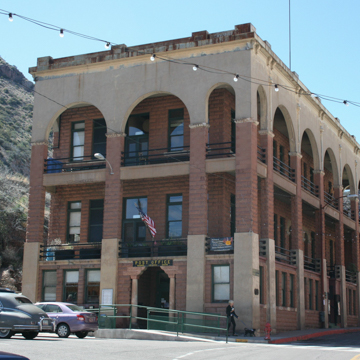Since this distinctly arcaded building was completed more than a century ago, it has been continuously occupied by a U.S. Post Office, on the ground floor, and the Copper Queen Library, on the third. It was built in 1906 and first occupied in April 1907. In addition to the post office and library, it originally housed reading, game, and card rooms on the second floor.
This was the fourth location for Bisbee’s lending library, which Copper Queen Mining Company executives organized in 1882 with 400 donated volumes and a small space in the company’s mercantile store. Local lore claims that company executives established the library as a way to curb violence after a lynching occurred in Bisbee. Whatever the reason, the library became so popular that the company gave it a permanent home in 1885. This two-story, wood-frame structure housed the circulating library and the town’s post office on the first floor with the second floor let for lodge meetings, church services, and social dances. When that building (including the books) was destroyed by fire in 1888, it was replaced with a brick structure in 1892. That Italianate building, which also included a game room, stood for 14 years before it was demolished to make room for the current edifice.
Because of Bisbee’s steep topography (its hills are considered too great an obstacle for mail-laden postal carriers), the town has never had home delivery. As a result, the downtown post office is a significant community institution. Although the post office and the library were under the same roof at the end of the nineteenth century, by 1904 the postal service had relocated to rowdy precinct of Brewery Gulch. When the townspeople learned that the Copper Queen Mining Company was planning a new library building in 1906, they petitioned the governor to move the post office into the library’s ground floor. By 1908, the Bisbee Post Office had the greatest number rented locked boxes (3,200) of any postal department in the country (due mainly to its lack of home delivery); it also had an all-female staff, the only such post office in the nation.
The Copper Queen Library and Post Office was designed by local architect Frederick C. Hurst (1856–1923), who had come to Bisbee from Canada in 1902 to work as an engineer for Phelps Dodge and Company (PD). During his tenure at PD, Hurst also designed the Bisbee Women’s Club (1902), housed in an Arts-and-Crafts bungalow; the Colonial Revival Copper Queen Hospital (1902); and the Renaissance Revival Central School (1905). In 1906, Hurst joined two other architects to form Perkins, Holden and Hurst. Within a few years, the firm had drafted designs for 14 buildings in downtown Bisbee, including the Old City Hall, the Fair Store, the Orpheum Theater, the fire station, and the Elks Lodge as well as a number of private residences.
The Post Office and Library building has a polygonal footprint that adheres to its prominent yet irregular site, wedged between Main and Commerce streets. It fronts what is colloquially called “Post Office Plaza,” and marks the entrance to Bisbee’s commercial center. The three-story structure is composed of concrete and gypsum blocks cut into two different sizes: 12 by 24 inches and 16 by 32 inches. The stone was produced in Douglas and treated to appear as brownstone. Exterior balconies wrap around the eastern and northern elevations on the second and third stories, behind full-height arches differentiated by reddish blocks that contrast with the buff-colored concrete, which alternate by story. A simple cornice with dentils and brackets masks the flat roof. With its arcades and piers, exterior rustication, and classical details, the Post Office and Library is modestly Renaissance Revival in style. It remains one of the most distinctive buildings in Bisbee.
In 2007, the century-old structure was renovated and an elevator was installed, but after 110 years, the building still continues to function as a post office on the ground floor with the Copper Queen Library above.
References
City of Bisbee. “Library History.” Bisbee, Arizona. Accessed September 5, 2017: http://www.bisbeeaz.gov/.
Perreault, Bill, and Carmen Graham. “Bisbee Woman’s Club House,” Cochise County, Arizona. National Register of Historic Places Registration Form, 1985. National Park Service, U.S. Department of the Interior, Washington, D.C.
Schwantes, Carlos A. Vision & Enterprise: Exploring the History of Phelps Dodge Corporation. Tucson: University of Arizona Press, 2000.
Vaughan, Tom. “Bisbee’s Post Office.” Arizona Capitol Times, April 10, 2015.
Wilson, Marjorie H., Janet Stewart, James Garrison, Billy G. Garrett, and Thomas S. Rothweiler, “Bisbee Historic District,” Cochise County, Arizona. National Register of Historic Places Registration Form, 1980. National Park Service, U.S. Department of the Interior, Washington, D.C.




















